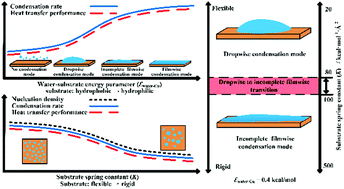Effect of substrate wettability and flexibility on the initial stage of water vapor condensation
Abstract
Understanding the mechanisms of controlling vapor condensation on surfaces is of significant importance in many fields. Despite many efforts made in the investigation of vapor condensation, few studies concern the condensation on flexible substrates, especially in microscale. In this paper, the condensation of high temperature water vapor on substrate with various flexibilities and wettabilities is investigated using molecular dynamics simulation. The results indicate that when substrates with the same flexibility vary from hydrophobic to hydrophilic, the condensation rate increases and the condensation mode changes from no-condensation to dropwise condensation, incomplete filmwise condensation and filmwise condensation, and meanwhile, the heat exchange between the water vapor and the substrate becomes more efficient; when substrates with the same wettability vary from rigid to flexible, the nucleation density, the condensation rate and the heat exchange efficiency increase significantly. In particular, the condensation modes on rigid and flexible substrates with the same wettability are generally the same except for the substrates with εwater–Cu = 0.4 kcal mol−1; and the critical values of substrate spring constant for the condensation mode transition are about 80–100 kcal mol−1 Å−2 when εwater–Cu = 0.4 kcal mol−1. Therefore, changing the flexibility of the substrate is proposed as a new way to control the condensation mode at the initial stage of water vapor condensation to meet design requirements.



 Please wait while we load your content...
Please wait while we load your content...